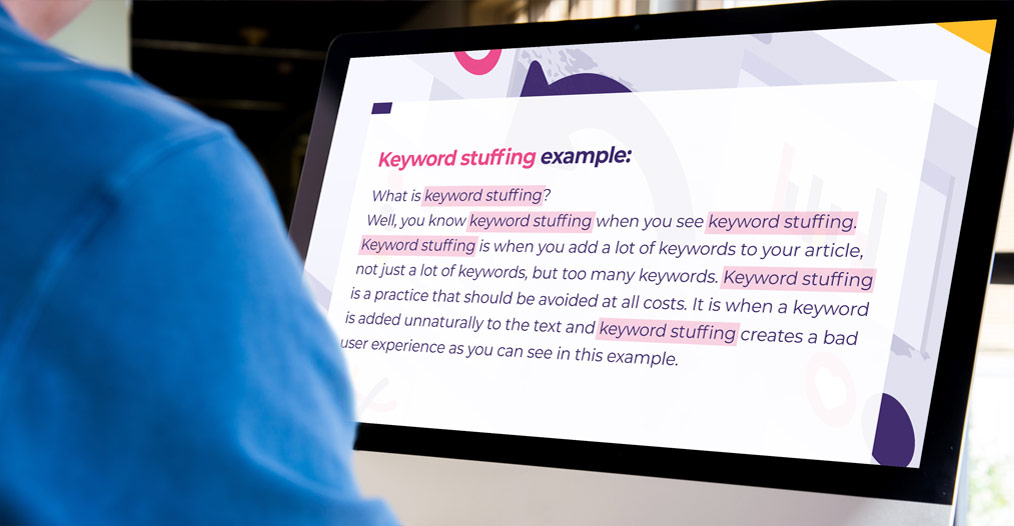Search Engine Optimization (SEO) is a multifaceted set of practices that you can use to improve the quality of your website for both your audience and search engines. One of the most used SEO practices is the use of SEO keywords in short and long-form content. Selecting words or phrases to use in your content isn’t just a guessing game. It is important to understand the “why” behind the terms you choose to ensure they help your brand, rather than hurting it. We’ll give you the basics that you need to understand to perform keyword research and how to use keywords in the best way possible.
Keywords are the words or phrases included in your web content that are meant to improve that content’s search ranking. Choosing a certain term helps search engines list or “rank” your content on the search results page that appears when someone performs a search for a related phrase or topic.
For example, if you create a webpage about your body lotion brand, you may want to use short terms like as “luxurious body lotion” or “natural body lotion.” When a search engine sees these words, it understands that this piece of content is meant to be both informative and transactional. Based on this, when a user searches for “body lotions to buy,” the search engine will know that your page is one the users may be interested in looking at.
And that’s just the start! SEO keywords can be used in a wide variety of content. This includes:
- Webpage or blog copy
- Image captions and alt tags
- Meta titles and meta descriptions
- Blog excerpts or summaries
- Social media captions
- Paid advertisements (yes, keywords are used in paid search but that is a topic for another blog post)

When researched and used well, these words are extremely beneficial to your organic search efforts.
Choosing the best possible keywords for your content is a crucial part of an effective SEO strategy. However, figuring out the right ones to use is an ongoing process, rather than a one-stop-shop. You need to select terms that have a high enough search volume to rank well with Google which also fit naturally into and are related to your content. Let’s look at a quick set of steps you can use to kick off your keyword research.
Create a list of topics or “buckets” to categorize your keywords. Keeping up with the body lotion example, you can create categories like “natural products,” “luxury brand,” and “skin health.” Then, brainstorm short or long terms that might work within these categories so you can start your research such as:
| Natural product | Luxury Brand | Skin Health |
|---|---|---|
| Natural lotion Eco-friendly lotion Naturally made lotion All-natural body lotion |
Luxurious lotion Luxury body lotion High-end body lotion |
Lotion for acne Body lotion to help skin Lotion to combat acne |
Remember, cultivating a general list of words is a starting point that you can build off of. Research should help narrow down your keyword lists to the ones that will fit into your content most naturally and will be the most effective to use.
Take time to put yourself in your audience’s shoes. Think about who may be interested in purchasing what you have to offer and what mindset they may be in when they hunt for your product or service on Google, Bing, or another search engine. Terms can vary depending on whether a searcher is looking to buy a product (transactional) or research their options (informational). Variations may present as “affordable natural body lotions” versus “natural body lotion options.” Understanding a searcher’s intent can make your research more accurate and make it easier to select different terms for different content such as product pages or blog posts.
Free or paid, you need to use a keyword research tool to get the data, such as monthly search volume, that will allow you to refine your list of terms. The data you find will make it easier to either narrow down the list or add better terms to it. They can also provide questions or related keywords that can bring additional attention to your content. Free resources include sites like AnswerthePublic.com, Google Trends, or UberSuggest (warning, some free services offer limited searches or limited data). For those with the budget, you can sign-up for SEMrush, SpyFu, Moz, or other paid services.
When you finish your keyword research and a usable list of terms, the next step is choosing where to incorporate them. Remember these tips when determining how and where to use yours.
If you have a longer piece of content you’re writing, such as a blog post or a webpage, then it is best to use your key phrase as early in the text as possible. If possible, get it into the first paragraph. If it fits, make it work in the first sentence! The earlier it appears, the better the content may rank.
Try to use your keyword more than once if you can incorporate it naturally. Incorporate them into section headers along with the body content. Don’t force it or overdo it though. Trying to use a keyword an excessive amount when it is unnecessary or unnatural can easily fall into the “keyword stuffing” territory.
Try to come up with a main keyword along with related terms or phrases that you can use in your content If you are focusing on creating content about “body lotion” for example, variations could include “natural body lotion,” “affordable body lotion,” and “eco-friendly body lotion.” You can go beyond this with questions or phrases like, “What are the benefits of using natural body lotion?” Longer terms can work well as a section header for longer content or even an FAQ section featured on a search results page.
Don’t skip the meta data! You should be using this for all kinds of content you produce anyways. If you aren’t using keywords in your meta data already though, see if you can start. This is very helpful for indexing and improved rankings on search engines which makes your content easier for your target audience to find.
How is your content performing? Are people seeing it? Is it ranking? Make sure to assess how your content performs over the months and years to see if you’d benefit from updating or changing the keywords you’ve used.
Remember, SEO is a long game– results take time but can have a big pay-off!

Keyword stuffing is a practice that some people try using to maximize the benefits of high-volume terms or phrases. It’s a cheating tactic, which makes it Black Hat SEO, and it will backfire in the future.
An example of this may be using high-volume keywords and their variations excessively in the content. We’ve also seen the inclusion of text that is stuffed with keywords but made invisible to increase the page rank without actually improving the content itself.
While Black Hat SEO tactics may yield results for a bit, eventually your website will get flagged or de-listed by the search engine, so no one sees it anymore. Research and selection take time, but they pay off far more sustainably than shortcuts like keyword stuffing ever will.
Planning a usable SEO strategy and conducting keyword research are important for the success of any brand in the online space, but they can also be time consuming. Varga Marketing, Inc. can save you time and stress when you let our experts tackle Search Engine Optimization and keyword research for you. Find out to find out how we can make every part of SEO easier on you.









